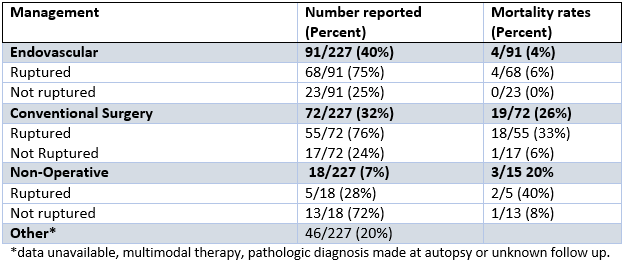Back to 2016 Annual Symposium ePosters
A comprehensive review of all published literature on the management of pancreaticoduodenal artery aneurysms
Alan M. Dietzek, MD, Stuart Blackwood, MD, Mohammed S. Sheikh, MS.
Danbury Hospital, Danbury, CT, USA.
OBJECTIVE: We report a systematic review of all of pancreaticoduodenal artery aneurysms documented in the English literature. We aim to characterize the clinical characteristics, epidemiology and changing trends in the management of these rare aneurysms.
METHODS: A comprehensive search of all reported pancreaticoduodenal artery aneurysms was performed including all aneurysms reported from 1895 to January 2015.
RESULTS: A total of 260 distinct patients were identified, 18 were excluded due to missing data or inability to translate the articles into English. Of the remaining 242 patients 41% were female, and 59% male. The most common presenting symptom was epigastric pain. The most common co-existent illnesses were HTN (20%) and chronic pancreatitis (10%). Co-existent celiac artery stenosis or occlusion was identified in 60% of all identified patients. Of the cases in which presentation was reported 126/237 (53%) presented emergently as a ruptured aneurysm with an overall 21% mortality rate. The method of diagnosis prior to 2000 was primarily by laparotomy based on physical exam, angiography or plain radiographs. After 2000 most diagnoses were secured via CT or conventional angiography. Findings of a bruit or the reliance on physical exam was almost unheard of or unreported after 2005. Finally, a variety of treatment options summarized below in the table show improved survival with endovascular therapy.
CONCLUSION: Successful management of these aneurysms has been achieved using a variety of conventional surgical and endovascular therapies in both emergent and non-emergent settings. Studies published in the 21st century suggest improve diagnostic capabilities and a significant improvement in survival using an endovascular approach. Open surgical techniques nonetheless remain a viable option when endovascular therapy is either not available or fails to control hemorrhage. 
Back to 2016 Annual Symposium ePosters
|







